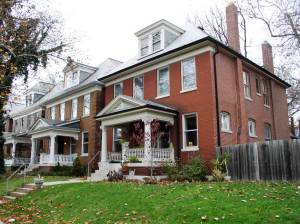Neoclassical Revival

Hendersonville, NC. County Courthouse. The neoclassical style was immensely popular for early 20th century public buildings, designed with Greek porticos, columns, and pediments.
PERIOD OF POPULARITY: 1893 – 1940 (primarily 1900 – 1929)
INTRODUCTION TO REVIVAL STYLES: Each revival style identifies specifically with an architecture of an earlier time and place, especially those related to early American or European precedents. Several popular revival styles are included on this blog, though other, less popular revival styles also appeared. To classify this grouping of architectural styles presents a challenge, as one could argue that many earlier Victorian styles were similarly revivalist. In fact, one publication includes several revival styles within the larger category of Victorian architecture (Cunliffe, et. al. 2010). The concept of “period styles” has also been adopted by some writers (including this one), though it was an early 20th century term used by non-professionals to romanticize the past. On the flip side are the architectural historians who prefer the more academic “Age of eclecticism” or “Eclectic Era,” which is an important concept to provide historical context here. The Eclectic Era, however, includes both revival and early modern styles that competed ideologically and appeared nearly simultaneously before the Great Depression. For purposes here, then, “revival styles” seems most appropriate, adapted widely across America for use in middle-class homes, wealthy country houses, commercial buildings, early skyscrapers, and civic buildings. Though overlapping with the more picturesque Victorian era, these styles largely gained popularity during the first two decades of the 20th century and heavily influenced our residential and commercial landscapes.
During this time (mostly between 1900 and 1929), accuracy of styles became important once again, unlike Queen Anne style, which borrowed from a variety of sources. Most Important, revival styles look to the past for inspiration. The trend toward revivalist architecture gained momentum from the 1893 Chicago World’s Fair, the Columbian Exposition, where historical interpretations of European styles were encouraged. Simultaneous to the rise of revivalist architecture, the modern era saw its beginnings with architects who were instead looking to the future, not to the past, with more progressive, modernist styles. Thus defines the Eclectic Movement of the early 20th century, which consisted of a simultaneous and perhaps competing interest in both modern and historic architectural traditions. This variety, or eclecticism, provided for one of the most diverse and colorful periods for architecture and urban design in American history, when almost anyone with at least a middle-class income could choose from one of a dozen or more styles for their home.
HISTORICAL BACKGROUND AND FEATURES: Neoclassical Revival became a dominant style for domestic buildings nationwide between 1900-1940s. It was directly inspired by the Beaux-Arts style and the Columbian Exposition (Chicago World’s Fair, 1893). The style tends to include the features of classical symmetry, full-height porch with columns and temple front, and various classical ornament such as dentil cornices. Basically, this is the revival of the Greek Revival style that dominated the first half of the 19th century. Because the style was more scaled down and flexible than its grander cousin, the Beaux-Arts, Neoclassical spread prolifically throughout the U.S. and became popular for a wide range of everyday buildings. Everything from townhouses, suburban homes, county courthouses, main street commercial buildings, and bank branches readily employed variations of the style. Often the single identifying feature on simpler structures (such as townhouses) might be the prominent columned porch with Greek portico above the entryway. Also unlike Beaux-Arts style, Neoclassical buildings tend to stick with pure Greek elements, especially the trabeated (post and lintel) form of Greek temples, with their columns, entablatures, and triangular pediments. In contrast, Beaux-Arts tends to incorporate both Greek and Roman forms, particularly that of the rounded, Roman arch.
For More Photos of Neoclassical Revival on Flickr, Click Here.

Redlands, CA. Train depot with prominent classical portico and Doric columns. Railroad companies usually adopted cultural fashions popular at the time, including architecture.

Ashville, NC. Sometimes referred to as a "southern pyramidal" or "railroad cottage," many smaller homes in the South and elsewhere used square columns to reflect the neoclassical style.

Branford, CT. Blackstone Public Library, c.1893-96. Designed with a prominent temple front and central dome (rotonda), a neoclassical form inspired by Jefferson's home at Monticello, in turn influenced heavily by Andrea Palladio's Villa Capra (La Rotonda) near Vicenza, Italy.

San Antonio, TX. Some neoclassical porticos can dominate a facade, as with this two-story version and its double columns.

Lewistown, PA. c.1927. Embassy Theatre. Small-town version of the style often featured symmetrical facades, squared-off roof lines, and classical details such as pilasters.

Flagstaff, AZ. Blome Building, campus of Northern Arizona University. Due to its symbolism related to Jeffersonian democracy and education, neoclassical buildings were popular on college campuses through the 1940s.

Neoclassicism continued to be a major force in academic art through the h century and beyond—a constant antithesis to Romanticism or Gothic revivals —although from the late h century on it had often been considered anti-modern, or even reactionary, in influential critical circles. The centres of several European cities, notably St Petersburg and Munich, came to look much like museums of Neoclassical architecture.